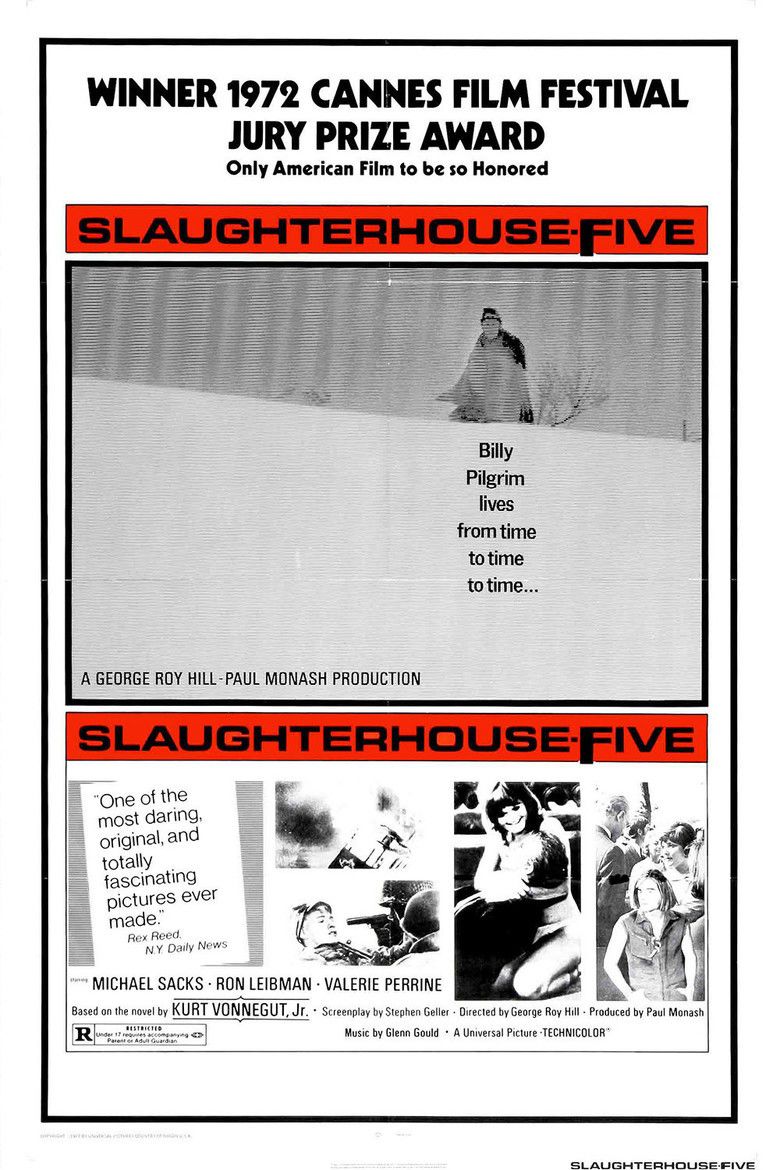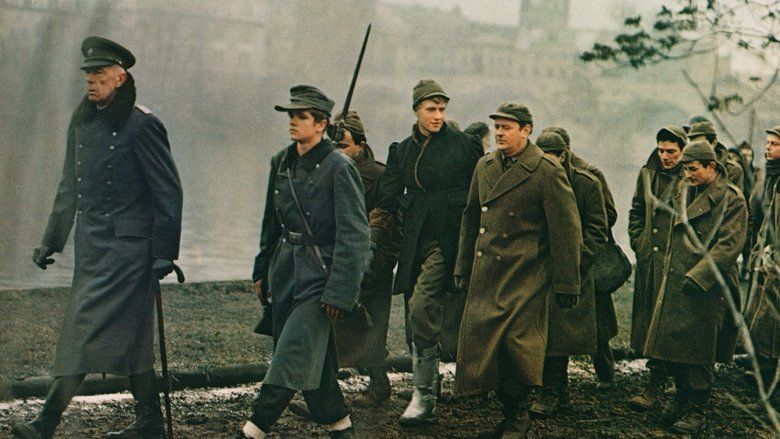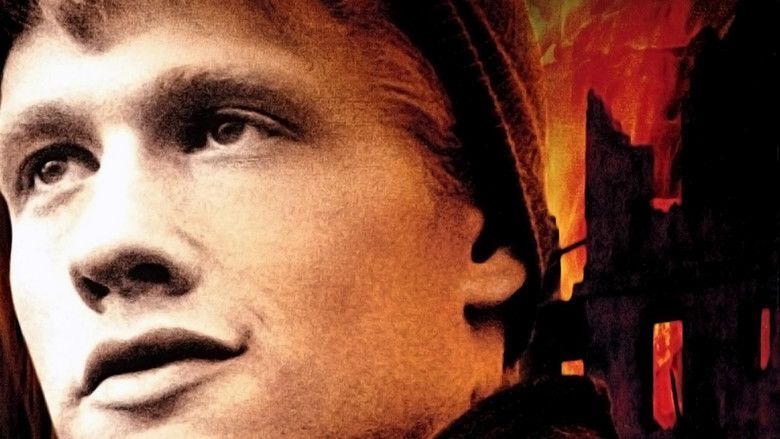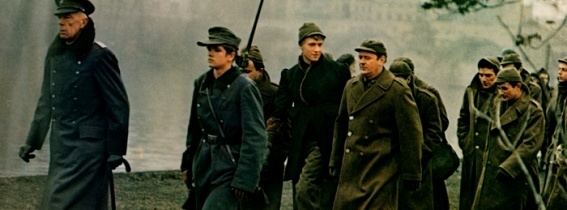Slaughterhouse Five (film)
7.4 /10 1 Votes7.4
77% Rotten Tomatoes Genre Comedy, Drama, Sci-Fi Duration Language English | 7/10 IMDb Country United States | |||||||||||||||||||||||||||||||||
 | ||||||||||||||||||||||||||||||||||
Release date March 15, 1972 (1972-03-15) Adapted from Slaughterhouse-five, Or, The Childrens Crusade: A Duty-dance with Death Cast (Billy Pilgrim), (Paul Lazzaro), (Edgar Derby), (Valencia Merble Pilgrim), (Montana Wildhack), (Barbara Pilgrim) Similar movies Mad Max: Fury Road , Interstellar , Guardians of the Galaxy , The Avengers , Avatar , Edge of Tomorrow Tagline Billy Pilgrim lives - from time to time. | ||||||||||||||||||||||||||||||||||
Slaughterhouse five official trailer 1 valerie perrine movie 1972 hd
From his home in Ilium, N.Y., optometrist Billy Pilgrim (Michael Sacks) narrates the tale of how he came to be "unstuck in time." Kidnapped by aliens and living in comfort with his assigned mate, B-movie starlet Montana Wildhack (Valerie Perrine), Billy experiences the events of his life in random order, flitting between his past as an American prisoner of war in World War II, to his humdrum middle-class life in the present-day, to his future as a zoo curiosity on the planet Tralfamadore.
Contents
- Slaughterhouse five official trailer 1 valerie perrine movie 1972 hd
- Aliens time travel and dresden slaughterhouse five part i crash course literature 212
- Plot
- Cast
- Differences from the novel
- Music
- Awards
- References

Slaughterhouse-Five is a 1972 film based on Kurt Vonneguts novel of the same name about a writer who tells a story in random order of how he was a soldier in WW2 and was abducted by aliens. The screenplay is by Stephen Geller and the film was directed by George Roy Hill. It stars Michael Sacks, Ron Leibman, and Valerie Perrine, and features Eugene Roche, Sharon Gans, Holly Near, and Perry King. The scenes set in Dresden were filmed in Prague. The other scenes were filmed in Minnesota.
Vonnegut wrote about the film soon after its release, in his preface to Between Time and Timbuktu:

"Listen: Billie Pilgrim has come unstuck in time." Slaughterhouse-Five is an award-winning 1972 film adaptation of Kurt Vonnegut's novel of the same name. Director Hill faithfully renders for the screen Vonnegut's obsessive story of Pilgrim, who survives the 1945 firebombing of Dresden, then lives simultaneously in his past, present, and future.
"I love George Roy Hill and Universal Pictures, who made a flawless translation of my novel Slaughterhouse-Five to the silver screen ... I drool and cackle every time I watch that film, because it is so harmonious with what I felt when I wrote the book."Aliens time travel and dresden slaughterhouse five part i crash course literature 212
Plot

The film follows the novel in presenting a first-person narrative from the point of view of Billy Pilgrim (Sacks), who becomes "unstuck in time" and experiences the events of his life in a seemingly random order, including a period spent on the alien planet of Tralfamadore. Particular emphasis is placed on his experiences during World War II, including the bombing of Dresden in World War II, as well as time spent with fellow prisoners of war Edgar Derby (Roche) and the psychopathic Paul Lazzaro (Leibman). His life as a husband to Valencia (Gans), and father to Barbara (Near) and Robert (King) are also depicted, as they live and sometimes even enjoy their life of affluence in Ilium, New York. A "sink-or-swim" scene with Pilgrims father is also featured. The scenes of extraterrestrial life on Tralfamadore feature Hollywood starlet Montana Wildhack (Perrine).
Cast
Differences from the novel
In addition to the condensation, there are a number of differences between the novel and the film, including the following:
The entire prologue in which Vonnegut meets with his old war buddy and decides to name his story The Childrens Crusade is omitted to focus on the fictionalized story of Billy Pilgrim. The opening scene, which focuses many times on Billy typing a letter to the editor of the newspaper, is actually set much later in the novel.
Several elements of the novel are missing from the film. Two characters, Kilgore Trout and Vonnegut himself, are omitted. The sequence in the novel where Pilgrim watches a movie about a bombing mission in World War II forward and then backward is also omitted because it would not have worked inside the time constraints of the film, even though Vonnegut regretted it. The novel includes repeated references to insects in amber, which are missing from the film. Pilgrims abduction scene is shorter in the film and also misses details, such as the appearance of the flying saucer, said to be 100 feet in diameter, with purple light pulsating around the saucers portholes along the rim.
In the film, Derbys execution happens immediately after he innocently takes a small porcelain figurine from among the ruins of Dresden. In the novel, he is put on trial first, and is executed for taking a teapot. The scene that sets up the significance of the figurine, where Derby mentions one in a letter to his wife, is also unique to the film.
The Tralfamadorian response to death and mortality, "so it goes", is not spoken once in the film despite being used one hundred and sixteen times in the novel.
Toward the end of the movie Billy helps some of his buddies to collect a huge grandfather clock. When the Russians arrive, his friends leave him alone, buried under the clock. Although the image created by this scene (the pressure of time on Billy Pilgrim) fits nicely into the plot, this part is also not found in the novel.
The bird that says "Poo-Tee-Weet" at the end of the novel is not in the movie.
Music
Slaughterhouse-Five is the first of two feature films for which Glenn Gould supplied the music. In this case it is in the form of needle drops from his Bach catalog, including Goldberg Variations Variation 25, and a performance of the third ("Allegro") movement from Keyboard Concerto #3 in D major and the second movement (Largo) of the Fifth harpsichord concerto. Goulds soundtrack actually included so little music in elapsed time, that the soundtrack album added atmospheric excerpts from Douglas Leedys synthesized triple album Entropical Paradise. A prolonged rendition of the final movement of Bachs fourth Brandenberg concerto accompanies a cinematic montage as the main character first encounters the city of Dresden.
Awards
The film won the Prix du Jury at the 1972 Cannes Film Festival, as well as a Hugo Award and Saturn Award. Both Hill and Geller were nominated for awards by their respective guilds. Sacks was nominated for a Golden Globe.
References
Slaughterhouse-Five (film) WikipediaSlaughterhouse-Five (film) IMDbSlaughterhouse-Five (film) Rotten TomatoesSlaughterhouse Five (film) themoviedb.org
